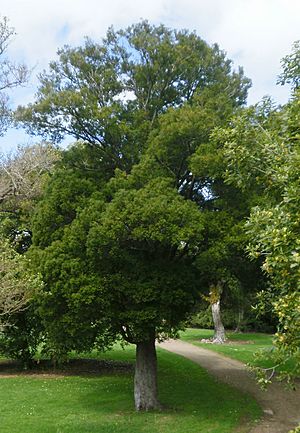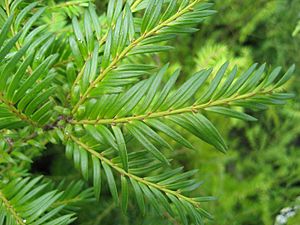Miro (tree) facts for kids
Quick facts for kids Miro |
|
|---|---|
 |
|
| Conservation status | |
| Scientific classification | |
| Genus: |
Prumnopitys
|
| Species: |
ferruginea
|
The miro (scientific name: Prumnopitys ferruginea) is a special type of evergreen coniferous tree. This means it keeps its leaves all year round, and it produces cones instead of flowers. The miro tree is found only in New Zealand, which makes it an endemic species.
Miro trees can grow very tall, up to 25 meters high. Their trunks can become quite wide, reaching about 1.3 meters across. The leaves are long and thin, usually 15–25 mm long and 2–3 mm wide. They have edges that curve downwards.
Miro trees have separate male and female plants. The male plants have small pollen cones. The female plants have unique seed cones that look like berries. These "berries" are oval-shaped, about 20 mm long, and turn red to purple-red when ripe. They have a soft, edible part covering a single seed.
The seeds of the miro tree are spread by the New Zealand pigeon. These pigeons love to eat the bright red "berries." When they digest the fruit, they pass the seeds in their droppings, helping new miro trees grow.
You can find miro trees growing in many places across New Zealand. They live in low-lying areas and on hillsides throughout the North and South Islands, as well as on Stewart Island/Rakiura. These trees can live for a very long time, often more than 600 years!
The scientific name ferruginea comes from a Latin word meaning "rusty." This name was chosen because the dried leaves of the miro tree often turn a rusty color.
Contents
How to Spot a Miro Tree
It can be tricky to tell the miro tree apart from another New Zealand native, the matai (Prumnopitys taxifolia). But there are a few key differences in their leaves, cones, and bark.
Leaves: Miro vs. Matai
- Miro trees have longer and wider leaves. The underside of miro leaves is green.
- Matai leaves are usually white underneath.
- Miro leaves often narrow to a sharp point. Matai leaves are more rounded, sometimes with a tiny point at the very tip.
- Miro foliage looks fine, flat, and feathery.
Cones: Miro vs. Matai
- Miro trees have cones that are red or reddish in color when ripe.
- Matai cones are blue-black.
- Miro cones are also longer and more oval-shaped compared to matai cones.
Bark: Miro vs. Matai
- Both miro and matai trees have bark that flakes off as they get older. This leaves a pattern that looks like "hammer marks."
- However, the pattern on miro bark is not as clear or colorful as on matai bark.
- When bark flakes off a matai tree, the fresh patches underneath are often a bright red color. This red color fades to brown over time. Miro bark does not show this strong red color.
See also
 In Spanish: Prumnopitys ferruginea para niños
In Spanish: Prumnopitys ferruginea para niños



